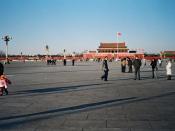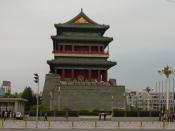The curbs are high in Beijing. You won't find slopes or slanted paths leading the old or crippled from the chaotic street to the safety of the pavement. China ignores its most disadvantaged. Millions living in abject poverty while the government spends $3 billion on an opera house. The 7% of the country able produce food for 1.3 billion people now shrinking due to the relentless rate of desertification, and yet $3 billion had been earmarked to send a rocket sprorting the Chinese flag around the earth 14 times, using the same technology the now defunct Soviet Union used for the same feat four decades previously. Just on the outskirts of Beijing rises the Chateau Zhang Laffitte, a carbon-copy of the original 1650 Chateau Maisons-Laffitte on the Seine using the same white Chantilly stone. Hundreds of peasants were thrown off their land to allow one man to spend $50 million to build.
A country that denies the most basic rights to its most vulnerable (and hence among the world's most vulnerable) to increase the wealth of its minorities sounds like a throwback to the KMT in the China before its overthrow in 1949. But the the man who was permitted to build such an ediface to greed, adding to it a moat, gardens that mirror those of Louis XXIV, and walls overlooking the grounds' golf course defended by guards is a member of the communist party, a party that serves itself as a wall, from which the peasants must peer over to see what has been taken from them, denied them. Those that the party claimed to liberate the country from over 5 decades ago are now in power, its only raison d'existence to maintain power in its geriatric hands while strengthening the wall for unadulterated capitalism.
In that...


